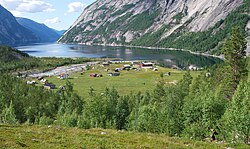Northern Norway
| |
|---|---|
 Hellmobotn in Hamarøy where Norway is at its narrowest. | |
 | |
| Country | Norway |
| Capitals | Tromsø, Bodø, Vadsø |
| Counties (fylker, fylke) | |
| Area | |
| • Total | 112,951 km2 (43,611 sq mi) |
| Population (2020) | |
| • Total | 482,000 |
| • Density | 4.3/km2 (11/sq mi) |
| Demonym | Nordlending |
| Nominal GDP (2013) | $27 billion |
| Nominal GDP per capita (2013) | $58,000 |
Northern Norway (Bokmål: Nord-Norge, Urban East Norwegian: [ˈnûːrˌnɔrɡə], Nynorsk: Nord-Noreg; Northern Sami: Davvi-Norga) is a geographical region of Norway, consisting of the three northernmost counties Nordland, Troms and Finnmark, in total about 35% of the Norwegian mainland. Some of the largest towns in Northern Norway (from south to north) are Mo i Rana, Bodø, Narvik, Harstad, Tromsø and Alta. Northern Norway is often described as the land of the midnight sun and the land of the northern lights. Farther north, halfway to the North Pole, is the Arctic archipelago of Svalbard, traditionally not regarded as part of Northern Norway.
The region is multi-cultural, housing not just Norwegians but also the indigenous Sami people, Norwegian Finns (known as Kvens, distinct from the "Forest Finns" of Southern Norway) and Russian populations (mostly in Kirkenes). The Norwegian language dominates in most of the area; Sami speakers are mainly found inland and in some of the fjord areas of Nordland, Troms and particularly Finnmark – though ethnic Sámi who do not speak the language are found more or less everywhere in the region. Finnish is spoken in only a few communities in the east of Finnmark.